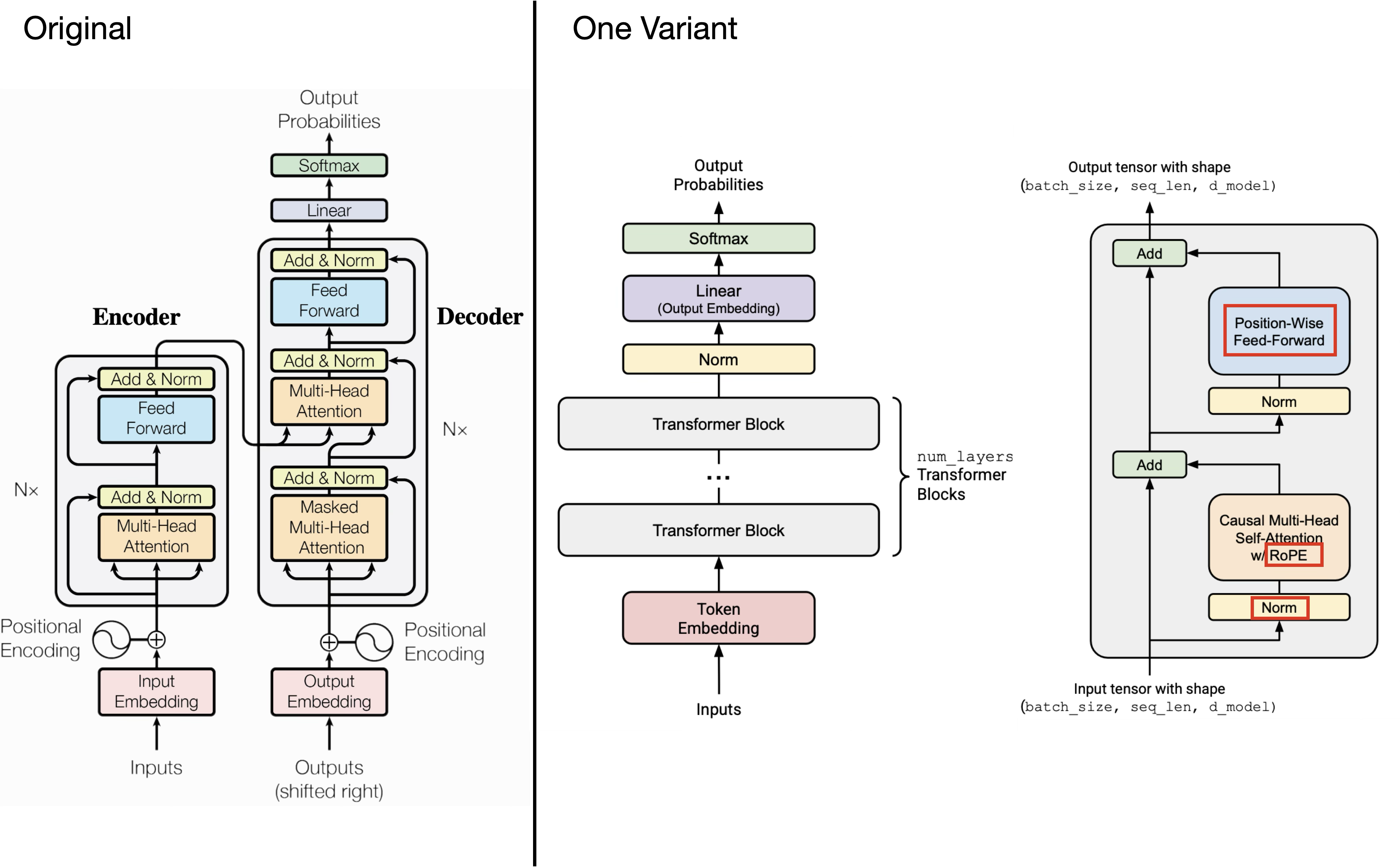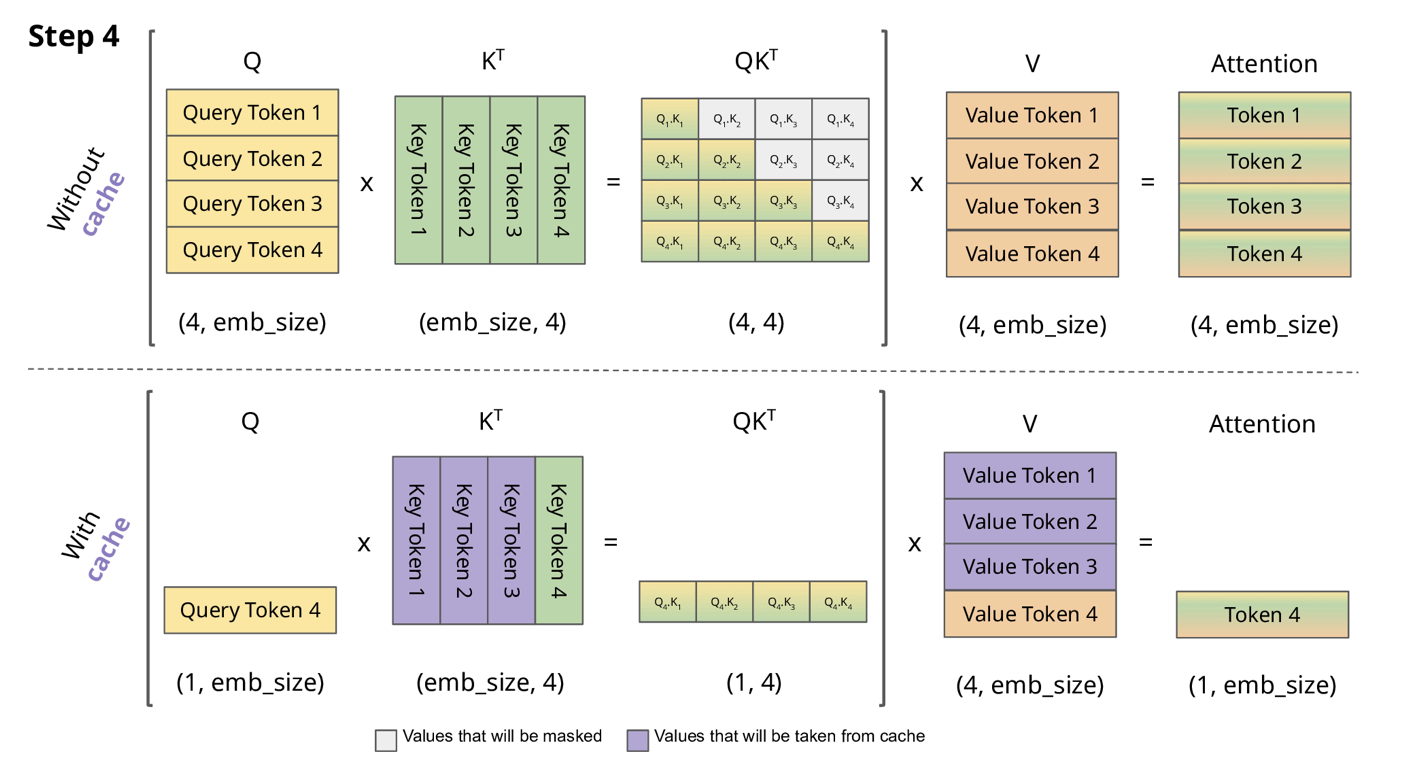2. Transformer Development #

1. Original Transformer #
Steps:
- $\operatorname{FFN}\left(\tilde{z}^{l}\right)=\max \left(0, \tilde{z}^{l} W 1+b 1\right) W 2+b 2$
1. Input embeddings: $ z^0 = E(x) + PE $, positional enocding: sines and cosines
2. Encoder (repeat $N$ times):
$$ \tilde{z}^l = \text{LN}(z^{l-1} + \text{MHA}(z^{l-1})), \quad z^l = \text{LN}(\tilde{z}^l + \text{FFN}(\tilde{z}^l)), \quad z^{enc} = z^N $$3. Decoder input: $y^0 = E(y) + PE, \quad y=(\langle\mathrm{sos}\rangle, y 1, y 2, \ldots, y T-1)$
4. Decoder (repeat $N$ times):
$$ \tilde{y}^l = \text{LN}(y^{l-1} + \text{MaskedMHA}(y^{l-1})) $$$$ \hat{y}^l = \text{LN}(\tilde{y}^l + \text{CrossAttn}(\tilde{y}^l, z^{enc})), \quad (Q=\tilde{y}^{l} W_Q, \quad K=z^{e n c} W_K, \quad V=z^{e n c} W_V) $$$$ y^l = \text{LN}(\hat{y}^l + \text{FFN}(\hat{y}^l)), y^{dec} = y^N $$5. Output layer:
$$ o = y^{dec} W_{out} + b_{out}, \quad P = \text{softmax}(o) $$2. Architecture variations #
1. use prenorm instead of postnorm: keep the good parts of residual connections; make the training more stable,no need to warm up
- $y=x+$ MHA(RMSNorm($x$)), $y=y+$ SwiGLU(RMSNorm(y))
- use double norm: (some architecutres) LN -> MAH/FNN ->LN
2. use RMSNorm instead of LayerNorm: fewer operations, less memory movement
- LayerNorm – normalizes the mean and variance across $𝑑_{𝑚𝑜𝑑𝑒𝑙}$: $y=\frac{x-\mathrm{E}[x]}{\sqrt{\operatorname{Var}[x]+\epsilon}} * \gamma+\beta$
- RMSNorm: no mean subtraction/bias: $y=\frac{x}{\sqrt{||x||_{2}^{2}+\varepsilon}} * \gamma$
3.FFN: No Bias Term: memory (similar to RMSnorm) and optimization stability
- original: $\operatorname{FFN}(x)=\max \left(0, x W_{1}+b_{1}\right) W_{2}+b_{2}$
- most(if not gated): $FFN(x)=\sigma\left(x W_{1}\right) W_{2}$
4. Gated Activation
- ReLU: $F F(x)=\max \left(0, x W_{1}\right) W_{2}$
- GeLU: $F F(x)=\operatorname{GELU}\left(x W_{1}\right) W_{2},\quad G E L U(x):=x \Phi(x)$
- modern: Gated activations: Instead of a linear + ReLU, augment the above with an (entrywise) linear term. Gated models use smaller dimensions for the $d_{f f}$ by $2 / 3$.
- $FFN_{\text{ReGLU}}(x)=\left(\max \left(0, x W_{1}\right) \otimes x V\right) W_{2}$
- $FFN_{\text{GEGLU}}\left(x, W, V, W_{2}\right)=(\text{GELU}(x W) \otimes x V) W_{2}$
- SwiGLU (swish is $x * \operatorname{sigmoid}(x)$ )
- $FFN_{\text {SwiGLU }}\left(x, W, V, W_{2}\right)=\left(Swish_{1}(x W) \otimes x V\right) W_{2}$
5. Serial instead of Parallel Layers
- Parallel: $y=x+\operatorname{FFN}(\operatorname{Norm}(x))+\operatorname{Attention}(\operatorname{Norm}(x))$
- Serial: $y=x+\operatorname{FFN}(\operatorname{Norm}(x+\operatorname{Attention}(\operatorname{Norm}(x)))$
6. Position EMbedding: use ROPE for relative embedding, implement at attention layer for Q, K
3. Hyperparameters #
- FF(RELU):$d_{f f}=4 d_{\text {model }}$, gated: FF(GLU): $d_{f f}=\frac{8}{3} d_{\text {model }}$
- $d_{head}*h=d_{model}$
- aspect ratio: $d_{\text {model }} / n_{\text {layer }}\approx 100$
- vocabulary size: monolingual models - 30-50k, Multilingual: 100-250k
4. Regularzation #
- becuase of large data, there is not a big issue on overfitting
- weight decay is interacting with learning rate schedule(cosine schedule) to improve the tranining, not due to regularization
- don’t need to do droupout
5. Stability tricks #
softmax: 1) before the output probability, and 2) in attention
- softmax= $\log (P(x))=\log \left(\frac{e^{U_{r}(x)}}{Z(x)}\right)=U_{r}(x)-\log (Z(x))$, $Z(x)=\Sigma_{r^{\prime}=1}^{|V|} e^{U_{r^{\prime}}(x)}$
- we want to make z(x) close to 1: so modify the loss function: $$ L=\sum\left[\log \left(P\left(x_{i}\right)\right)-\alpha\left(\log \left(Z\left(x_{i}\right)\right)-0\right)^{2}\right] $$
- normalize Q,K before attention
- Use more layernorm
- Soft-capping the logits to some maximum value via Tanh:
- logits $\leftarrow$ soft_cap $*$ tanh (logits/soft_cap)
6. Attention Heads #
GQA/MQA - Redudcing attention head cost
- grouped query attention, multi query attention
- artihmetic intensity is high
At training
- Arithmetic(FLOPS) calculation:
- $b$: batch size, $n$: sequence length, $d$: model width, $h$: #heads, $d_h=d/h$.
- Input $X\in\mathbb{R}^{b\times n\times d}$.
- Rule of thumb for a matmul: $(m\times n)\cdot(n\times p)$ costs $\approx 2mnp$ FLOPs.
Linear projections $Q=XW_Q,;K=XW_K,;V=XW_V,;O=\text{concat heads}\cdot W_O$. Each is $(bn\times d)\cdot(d\times d)\Rightarrow \approx 2,bn,d^2$ FLOPs.
Attention scores and mixing (per head) $S_t=Q_tK_{\pi(t)}^\top \in \mathbb{R}^{b\times n\times n}$: $(bn\times d_h)\cdot(d_h\times n) \Rightarrow 2,bn,n,d_h$. Across $h$ heads: $2,bn,n,h,d_h=2,bn^2d$.
Mixing $O_t=\mathrm{softmax}(S_t)V_{\pi(t)}$ is the same cost again: $2,bn^2d$.
$$ \boxed{\text{Arithmetic}}=\underbrace{8\,bn\,d^2}_{\text{4 projections}} \;+\; \underbrace{4\,bn^2d}_{\text{scores+mix}} \sim O(b n d^{2})$$
- Memory accesses (reads/writes)
Activations scale ($bnd$): Reading $X$ / writing outputs / intermediate tensors are all $\Theta(bnd)$.
Attention maps ($bhn^2$): For each batch and head you materialize (or at least stream) an $n\times n$ score/probability tile for softmax/mixing.
Weights ($d^2$): Loading the dense projection weights $W_Q,W_K,W_V,W_O$ is $\Theta(d^2)$.
$$ \boxed{\text{Memory } \sim\; bnd \;+\; bhn^2 \;+\; d^2 }. $$
- Arithmetic intensity
- $\mathrm{AI} \sim \frac{b n d^{2}}{d^{2}+b n d+b g n^{2}}\sim \frac{1}{b n}+\frac{1}{k}+$ smaller terms
- High AI ⇒ each byte loaded from memory is reused many times in math ⇒ compute-bound (GPU fully busy)
At inference: we need to incrementaly re-compute/update attention via the ‘KV cache’

(Picture from KV Caching@joaolages )
- Total arithmetric operations $\left(b n d^{2}\right)$, total memory accesses $\left(b n^{2} d+n d^{2}\right)$
- Arithmetic intensity is not good $O\left(\left(\frac{n}{d}+\frac{1}{b}\right)^{-1}\right)$ - need large batches + short seq length (n) or big model dimensions (d)
tbd
Step details #
0: Tokenization #
Before embeddings, raw text must be converted into token IDs.
Text input: Example:
"I like AI"Tokenizer:
- Splits text into units (tokens). Can be word-level, subword-level (BPE/WordPiece), or character-level.
- Each token is mapped to an integer ID from the vocabulary.
Example (WordPiece):
"I like AI" → ["I", "like", "AI"]Token IDs:
["I", "like", "AI"] → [101, 456, 982]- $101, 456, 982$ are indices into the vocabulary of size $V$.
- Each ID uniquely represents a token.
Results: $ \text{Token IDs} \in \mathbb{Z}^{B \times T}$,
- $B$ is batch size, $T$ is sequence length.
1: Token IDs → Embedding Vectors #
Embedding matrix: A learnable parameter $ E \in \mathbb{R}^{V \times d_{\text{model}}}$
- $V$: vocabulary size (e.g., 30,000)
- $d_{\text{model}}$: hidden dimension (e.g., 512, 768, 1024)
Lookup: For each token ID $t_i$, fetch its row in $E$: $ x_i = E[t_i] \in \mathbb{R}^{d_{\text{model}}} $
Stack into batch: $ X \in \mathbb{R}^{B \times T \times d_{\text{model}}} $
- $X[b, i, :]$: embedding for the $i$-th token in the $b$-th sequence.
2. Linear Projections for Q, K, V #
Each token vector is projected into query, key, and value spaces.
For multi-head attention with $h$ heads:
$$ Q = X W^Q, \quad K = X W^K, \quad V = X W^V $$where
$$ W^Q, W^K \in \mathbb{R}^{d_{\text{model}} \times (h \cdot d_k)}, \quad W^V \in \mathbb{R}^{d_{\text{model}} \times (h \cdot d_v)} $$Typically $d_k = d_v = d_{\text{model}}/h$.
Shapes:
$$ Q, K \in \mathbb{R}^{B \times T \times (h \cdot d_k)}, \quad V \in \mathbb{R}^{B \times T \times (h \cdot d_v)} $$Then reshape/split into heads:
$$ Q, K \in \mathbb{R}^{B \times h \times T \times d_k}, \quad V \in \mathbb{R}^{B \times h \times T \times d_v} $$
3. Rotary Positional Embeddings (RoPE) #
Initial Positional Encoding (absolute sinusoidal added to X):
For input X, For token position $i \in [0, T-1]$ and dimension index $k \in [0, d_{\text{model}}-1]$:
$$ PE_{i,2k} = \sin\!\Big(\tfrac{i}{10000^{2k/d_{\text{model}}}}\Big), \quad PE_{i,2k+1} = \cos\!\Big(\tfrac{i}{10000^{2k/d_{\text{model}}}}\Big) $$Then: $ X ;\leftarrow; X + PE $
why needed:
- Token embeddings alone carry meaning but no order (“I like AI” and “AI like I”), after this step Each position $i$ has a distinct vector PE.
- $1000^{2k/d_{\text{model}}}$: ensures that low dimensions correspond to slow frequencies (long wavelengths) and high dimensions to fast frequencies (short wavelengths):
- $k=0 \Rightarrow$ wavelength ≈ $10000^0 = 1$ (fast oscillations).
- $k=256 \Rightarrow$ wavelength ≈ $10000^{1} = 10000$ (very slow oscillations).
However, it will lose the information of relative position in $QK^T$ .
RoPE: RoPE encodes relative positions by rotating each query, key vector in 2D subspaces.
Input shapes: $ Q, K ;\in; \mathbb{R}^{B \times h \times T \times d_k} $
Split into 2D pairs:
- For each token position $i$ (T) and dimension index $k$ (d/2):
- $ (q_{i,2k}, ; q_{i,2k+1}) \in \mathbb{R}^2 $
Define rotation angle:
- $\theta_{i,k} = i \cdot \alpha_k, \quad \alpha_k = 10000^{-\tfrac{2k}{d_k}} $
Rotation matrix:
$$ R(i,k) = \begin{bmatrix} \cos(i\alpha_k) & -\sin(i\alpha_k) \\ \sin(i\alpha_k) & \cos(i\alpha_k) \end{bmatrix} \;\in\; \mathbb{R}^{2 \times 2} $$Apply Rotation:
- For queries (same for keys): $$ \begin{bmatrix} q'_{i,2k} \\ q'_{i,2k+1} \end{bmatrix} = R(i,k) \begin{bmatrix} q_{i,2k} \\ q_{i,2k+1} \end{bmatrix} $$
- This is equivalent to a complex multiplication if we treat
Result:
- Shapes unchanged: $ Q’, K’ ;\in; \mathbb{R}^{B \times h \times T \times d_k} $
- Enabling relative encoding naturally in dot products $Q’K’^T$. $$ (Q'K'^\top)^{ij} = \sum_{k} q_{i,k}'^\top k_{j,k}' = \sum_{k} q_{i,k}^\top \, R(j-i,k) \, k_{j,k} $$
4. Scaled Dot-Product Attention #
Attention score for head $j$:
$$ \text{Attn}(Q,K,V) = \text{softmax}\!\left( \frac{QK^\top}{\sqrt{d_k}} + M \right)V $$$M$ = attention mask of shape $(B,1,T_q,T_k)$ or broadcastable.
Typically:
- Padding mask → entries = $0$ for valid, $-\infty$ (or large negative) for masked.
- Causal mask → upper triangular matrix with $-\infty$ above diagonal.
Shapes
- $Q \in \mathbb{R}^{B \times h \times T_q \times d_k}$ (queries, length $T_q$)
- $K \in \mathbb{R}^{B \times h \times T_k \times d_k}$ (keys, length $T_k$)
- $V \in \mathbb{R}^{B \times h \times T_k \times d_v}$ (values, length $T_k$)
Steps:
- $QK^\top : (B,h,T_q,d_k) \cdot(B,h,d_k,T_k)\Rightarrow (B,h,T_q,T_k)$
- score $\left(Q K^{\top}\right)^{i j}=$ How much query position $i$ should pay attention to key position $j$
- $\text{softmax}(QK^\top / \sqrt{d_k}) \in (B,h,T_q,T_k)$
- Normalized along the key dimension ($T_k$).
- Multiply with $V$: $(B,h,T_q,T_k)\cdot(B,h,T_k,d_v) \Rightarrow (B,h,T_q,d_v)$
- Each query position ($T_q$) receives a weighted combination of all value vectors.
Special Cases
- Self-attention (encoder/decoder): $T_q = T_k = T$.
- Cross-attention (decoder attending encoder): $T_q$ (decoder length) can differ from $T_k$ (encoder length).
5. Concatenate Heads + Linear #
Concatenate across $h$ heads:
$$ (B,h,T,d_v) \;\;\Rightarrow\;\; (B,T,h \cdot d_v) \quad( = (B,T,d_{\text{model}})) $$Final projection:
$$ O = \operatorname{MultiHead}(Q, K, V)=\operatorname{Concat}\left(\operatorname{head}_{1}, \ldots, \operatorname{head}_{h}\right) W^O, \quad W^O \in \mathbb{R}^{(h \cdot d_v) \times d_{\text{model}}} $$Output of multi-head attention:
$$ O \in \mathbb{R}^{B \times T \times d_{\text{model}}} $$
6. Feed-Forward Network (FFN, e.g., SwiGLU) #
- Two (or three, if gated) linear layers applied position-wise.
For SwiGLU:
$$ \text{FFN}(X) = \big( \,\text{SiLU}(X W_1) \odot (X W_3) \,\big) W_2 $$with
$W_1, W_3 \in \mathbb{R}^{d_{\text{model}} \times d_{\text{ff}}}$
$W_2 \in \mathbb{R}^{d_{\text{ff}} \times d_{\text{model}}}$
Typically $d_{\text{ff}} \approx \tfrac{8}{3} d_{\text{model}}$, rounded to a multiple of 64.
Shape flow:
- Input: $(B,T,d_{\text{model}})$
- After $W_1$, $W_3$: $(B,T,d_{\text{ff}})$
- After gating: $(B,T,d_{\text{ff}})$
- After $W_2$: $(B,T,d_{\text{model}})$